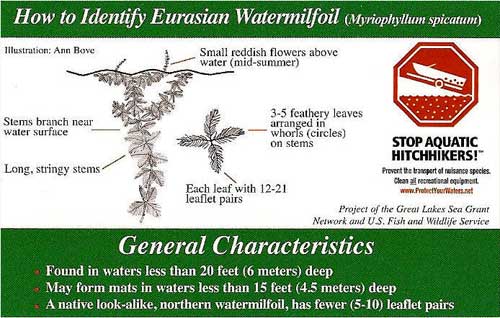Eurasian Watermilfoil
EURASIAN WATER MILFOIL HAS BEEN DISCOVERED IN CROW WING COUNTY, MINNESOTA!
Kimball Lake is on the latest infested water list. For the full list of waters infested by Eurasion water milfoil, go to:
http://files.dnr.state.mn.us/eco/invasives/infested_waters.pdf
IT IS CRITICAL TO REMOVE ALL VEGITATION FROM EQUIPMENT WHEN YOU LEAVE A BODY OF WATER!
Don’t be the one who lowers our property values, decreases our recreational fun and endangers our native species.
IF YOU THINK YOU HAVE FOUND A NEW INFESTATION OF EURASIAN WATERMILFOIL:
Contact the Minnesota Department of Natural Resources at 651.296.2835 or (888) 646-6367 or mail them a sample of a suspected milfoil plant in a sealed plastic bag.
Mail samples to:
Minnesota-DNR
Eurasian Watermilfoil Program
Ecological Services Section, Box 25
500 Lafayette Rd.
St. Paul, MN 55155-4025
HOW CAN YOU HELP PREVENT THE SPREAD OF EURASIAN WATERMILFOIL?
Eurasian watermilfoil may become tangled in boat propellers, transducers, trim tabs, bow lines, fishing nets, and on trailers. Actions you take as a responsible boater are critical in preventing the spread of Eurasian watermilfoil to other Minnesota waters.
Before leaving a lake or river:
- INSPECT and REMOVE all aquatic plants and animals
- DRAIN water from motors, live wells and bait containers
- DISPOSE of unwanted live bait on land
- RINSE your boat and equipment with hot (104°F) high pressure tap water or
- DRY your boat and equipment for at least 5 days
Eurasian versus Native Milfoil … one is a costly invader, the other belongs in Blackwater.
WHAT DOES EURASIAN WATERMILFOIL USUALLY LOOK LIKE?
- Submersed, rooted aquatic plant in shallow waters (less than 30 feet deep)
- Long branching stems near the surface with soft, feathery leaves
- Leaves usually attached in whorls of four, but sometimes 3-5
- Each leaf has 10-21 pairs of leaflets
- Leaflets are usually closely-spaced
- Leaves are limp when out of water
- Top of plants often turn red
- Small reddish flowers in mid summer
- Plants can grow up to 15 feet long
DON’T MISTAKE! Eurasian watermilfoil is only one of six aquatic plants in the watermilfoil family found in Minnesota. It is most commonly mistaken for native Northern watermilfoil which has these characteristics:
- Leaves attached to stem in groups of 4 (rarely 5)
- Each leaf has 5-9 pairs of leaflets
- Leaflets are widely-spaced
- Leaves are rigid when out of water
- Plant does not branch at surface
WHAT IS EURASION WATERMILFOIL?
Eurasian watermilfoil (Myriophyllum spicatum) is an invasive, submersed (underwater) aquatic plant accidentally introduced in the 1940s to North America from Europe, where it is widespread. It most likely reached eastern North America through the aquarium trade, entering the waters when aquarium owners released the contents of their aquariums into local lakes. Eurasian watermilfoil flourished and began to spread westward by clinging to recreational boats. People using Lake Minnetonka near Minneapolis, reported the first Eurasian watermilfoil infestation in Minnesota in 1987. Eurasian watermilfoil now occupies over 120 water bodies throughout the state.
WHY IS EURASIAN WATERMILFOIL A CONCERN?
Eurasian watermilfoil can form thick underwater stands of tangled stems and vast mats of vegetation on the water’s surface, especially in shallow, nutrient-rich water. These mats can limit boating, swimming, and fishing. Milfoil generally does not produce mats on the surface in water more than 15 feet deep, and doesn’t usually grow in water more than 20 feet deep.
Eurasian watermilfoil can disrupt the ecology of a water body by crowding out important native aquatic plants needed for a healthy fishery. It can potentially reduce property values. Under severe conditions, property owners and lake associations can expect increased costs to keep boat channels open by mechanical harvesting and for costs associated with disposal of rotting vegetation. However, it does not cause problems in every body of water where it is established. In lakes with low water clarity, milfoil does not produce mats in water more than six feet deep, if at all. In parts of lakes where bottom fertility is low, for example in sandy areas, the growth of milfoil and aquatic plants tends to be low.
The costs if hosting invading Eurasian watermilfoil:
FACTS
Impacts of Eurasian watermilfoil based on research:
- Increased boat repair and maintenance costs (One boat owner in Vermont spent $800 repairing his boat when the motor intake became clogged with milfoil)
- Declined native plant diversity (Madsen, et, al. 1991; Trebitz 1993)
- Depressed real estate values (Bates et. al 1985)
- Inhibited water circulation (Smart and Doyle 1995)
- Reduced levels of dissolved oxygen, enables nutrients to accumulate…possibly creating unfavorable conditions for macroinvertebrates and fish (Lillie & Budd 1992)
- Reduced density of invertebrates (fish food) (Keast 1984)
- Three to four times fewer fish versus native plant beds (Keast 1984)
- Caused significant increases in permanent pool mosquitoes (Bates et. al 1985)
WHAT ARE THE COSTS OF EURASIAN WATERMILFOIL CONTROL?
The Minnesota Department of Natural Resources spent approximately $120,000 for maintenance management of Eurasian watermilfoil in 1999!
HOW DOES EURASIAN WATERMILFOIL SPREAD?
Eurasian watermilfoil plants spread naturally through stem fragments and underground runners. Accidental cutting of the plants can start new plants when the fragments are transported by watercraft or on waves and currents to new areas where they can root and grow.

